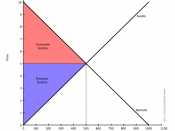Question 5 Firms often use price discrimination to increase profits. In order to price discriminate successfully, firms have to consider the possibility that consumers do not behave as expected (eg by buying in a different market) and the strategic responses of middlepersons / competitors (eg arbitrage). Review the theory of price discrimination and identify for each specific type of discrimination you consider the types of strategic responses that may occur. In the second part of your essay, describe a firm who tries price discrimination but did not achieve the maximum profit because of strategic responses.
Word count Part 1 - Theory Price discrimination occurs when a business tries to sell the same goods to different consumers at a different price.
This is not possible in a perfectly competitive market where there are many firms selling the same product where each firm takes the market price.
The continuously downward-sloping demand curve (Figure 1) indicates that not everybody values goods at the same price and as a result the price of a good which is set at virtually any price will sell some units.
As a general rule, a consumer will buy a good if it is priced at or below the level that consumer values it at. Some people, therefore, will get the good for a price less than their valuation, the difference being the consumer surplus.
For price discrimination to make an improvement to society, the surplus and dead-weight loss must be given to the monopolist or to society.
3 types of price discrimination exist Type 1 - A firm captures all the consumer surplus because it has detailed information on how much the customers is willing to pay for each unit. This type rarely exists as the firm will need to know the demand curve of each buyer. An...


